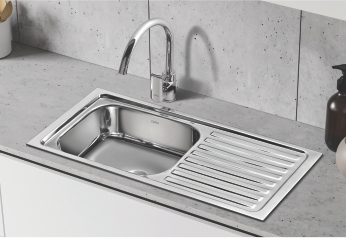When it comes to renovating or designing a kitchen, one of the essential components that demands consideration is the kitchen sink. It is not merely a functional fixture but also plays a significant role in defining the kitchen’s style and utility. Selecting the right sink for the kitchen involves understanding various materials, styles, configurations, and additional features available in the market.
Understanding Different Materials
The first step in choosing the perfect kitchen sink is deciding on the right material. There are several materials to choose from, each offering distinct advantages. Stainless steel is a popular choice due to its durability, resistance to rust and stains, and cost-effectiveness. It fits well with modern kitchen aesthetics, providing a sleek and clean appearance.
Another common material is porcelain, which adds elegance and a classic touch to traditional kitchen designs. Although beautiful, porcelain can be prone to chipping and requires careful maintenance. Granite composite sinks offer a high level of durability and a sophisticated look. They are resistant to scratches and stains, though they come at a higher price point. Cast iron sinks coated with enamel provide a heavy-duty option, known for their longevity and classic appearance.
Styles and Configurations
Once the material is chosen, the next decision involves the style and configuration of the sink. Single bowl sinks are excellent for those seeking a large, uninterrupted space for washing large pots and pans. Double bowl sinks are versatile, allowing users to multitask by providing separate areas for washing and rinsing or prepping food.
Farmhouse, or apron-front, sinks are increasingly popular for their aesthetic appeal and spacious design. They extend slightly from the countertop, providing more ergonomic access. Undermount sinks are installed beneath the countertop for a seamless look and are ideal for sweeping crumbs and water directly from the countertop into the sink. Drop-in sinks, or top mount sinks, are easy to install and replace, making them a practical choice for many.
Size and Depth Considerations
The size and depth of the sink are crucial considerations based on kitchen space and user needs. A deeper sink accommodates larger cookware but may require more bending to reach the bottom. The width should match the available counter space, ensuring enough room for installation without compromising the cabinet structure underneath.
Additional Features and Accessories
Modern kitchen sinks come with a range of additional features and accessories that enhance functionality. Integrated drainboards, cutting boards, and colanders add convenience for food preparation and cleanup. Choosing a sink with soundproofing pads or undercoat insulation can help minimize noise during use, providing a more serene kitchen environment.
Installation and Maintenance
The installation process varies depending on the type and complexity of the kitchen sink. Professional installation is often recommended, especially for undermount sinks that require precise cuts in the countertop. Maintenance considerations should also influence the choice, with stainless steel being easier to clean compared to materials like porcelain or granite composite, which may require special treatments.
Budgeting for Your Kitchen Sink
Costs can vary widely depending on the material, style, and additional features selected. Stainless steel sinks are generally the most budget-friendly, while granite composite and cast iron options are more expensive. It is essential to balance between cost, quality, and the expected lifespan of the sink to ensure a worthwhile investment.
Environmental Considerations
Those aiming for environmentally friendly kitchens should consider the material’s impact on the environment. Stainless steel is often made from recycled materials and is fully recyclable. Porcelain and cast iron can also be sustainable choices if sourced from reputable suppliers.
Trends in Kitchen Sinks
Kitchen design trends continuously evolve, and sinks are no exception. Current trends include matte black sinks, which provide a bold and modern look, and copper sinks that offer an antique charm and natural antimicrobial properties.
Conclusion
Choosing the perfect kitchen sink involves more than selecting a design that fits the aesthetic of your kitchen. It requires consideration of material durability, style, size, and additional features that accommodate your lifestyle needs. Fortunately, a wide variety of sinks are available from retailers such as Tradelink, providing options for every style and budget. With careful consideration and the right choice, the kitchen sink can seamlessly blend beauty and functionality in any kitchen space.

